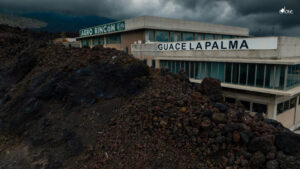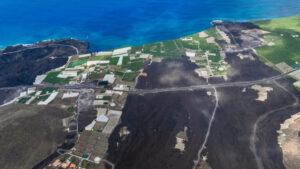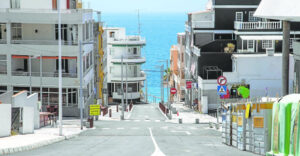08 Nov La Palma Reconstruction – October 2023

La Palma Reconstruction October 2023 Update
October 2023 news summaries from across La Palma regarding science in La Palma reconstruction efforts, aid provided to residents and industries, and other relevant news. Sources: La Palma Ahora, Cabildo de La Palma, El Time, ABC España, and El Valle de Aridane.
Aid
- €200 million for reconstruction in regional budgets: The draft decree for the 2024 Canary Islands budgets includes €200 million investment for La Palma, including specific items of €50 million for the economic and social recovery of the island, and €1 million for tourist infrastructure.
- €100 million for reconstruction: At a meeting in Madrid, the President of the Canary Islands has again pressed the Spanish Government over the delay in the execution of the €100 million in aid included in this year’s state budget for the reconstruction of La Palma. The President has received a commitment to do this from the finance minister of the Spanish Government.
- €5 million for SMEs: The government of the Canary Islands has approved a new €5 million loan for SMEs affected by the volcano. In total, the government has granted €10 million as part of the ‘La Palma is Activated’ plan for companies and the self-employed.
- €5 million for land to build homes: The President of the Cabildo de La Palma Sergio Rodriguez met with the Canary Islands Housing Initiative and municipality mayors in La Palma, to address the island’s housing issue. The Cabildo will give €5 million to make it easier for municipalities to buy land to build housing, in addition to the Government of the Canary Islands La Palma 700 and Rural Life initiatives. The legal changes that need to be made to allow the ‘La Palma 700’ plan to begin are expected to be completed next month.
-

El Time (2023) Los Llanos grants €300,000 in aid to companies affected by the volcano.
€300k for businesses in Los Llanos: The Los Llanos de Aridane City Council has paid €300k in aid to companies and self-employed people in the municipality affected by the volcano. This is part of a subsidy that was open until the 3rd
- Rental aid for new families: The Government of the Canary Islands has expedited rental aid payments to 76 families who have been incorporated into the system. They have been waiting a year to benefit from this aid, which they will receive retroactively. Rental aid will now be made monthly or bimonthly after criticisms, as many have had to wait 6 months or more to receive their first payment, which was unsustainable for some families who heavily relied on it.
Reconstruction
- Banana market recovery: The Canary Islands banana market has recovered to its pre-volcano levels. After the eruption, due to supply issues, some households have been consuming fewer bananas. The 2023 levels, at 291 million kg since the start of the year, represent an annual increase of 13% and 11 million kg more than in 2021.
- Camino Cruz Chica works: The recovery of the full Camino Cruz Chica road, between the La Laguna Junior School and La Laguna crossing, is due to be completed, which will give new access to 40 homes. As part of this, 30 m of lava have been excavated, to protect the remaining houses from the residual heat of the flows.
- LP-2 recovery update: Plans to recover the LP-2 road are being finalised, with the Cabildo de La Palma stating there will be minimal alteration of the territory and it will not affect current points of interest such as lava tubes. 5 alternatives were studied before the 6th was decided on, after many technical surveys by the scientific committee overseeing the project. The road could be 2 km long, and work is expected to start before the end of the year.
- Draft Agricultural Decree Update: The agricultural decree remains in draft form due to ongoing modifications to rectify constitutional irregularities in the current version. Current demands are for three options for farmers: to re-parcel their land and receive its value, for those who want to continue farming elsewhere, and for those who want to recover their farms in situ. Another important part of the decree is state-allocated aid, currently, the demand is for at least 4 more years of aid, with the Government of Spain contributing €100 million annually and the Government of the Canary Islands contributing €50 million annually.
-

El Time (2023) Lava flows in Tazacorte where new rebuilding licenses will be permitted.
Rustic housing licenses update: The latest update on the number of licenses granted to those affected to build housing on rustic land, which would normally not be allowed, has shown that 150 of these licenses have been granted to date. Tazacorte has granted 35 licenses for farmers to rebuild on plots partially affected by the lava flows, and 6 permits for reconstruction on the edge of the lava flows are awaiting approval in Los Llanos de Aridane. The Cabildo de La Palma has also urged municipalities to relax the restrictions around the rustic licenses, to lower the minimum plot size from 1,000 to 500 square metres.
- Those affected in hotels: The latest figures show that 65 people affected by the volcano remain housed in hotels, almost two years since the eruption ended.
Science
- Lack of communication before the eruption around location: IGN scientist Carmen Lopez has described how the IGN closely predicted the location of the eruption, and that this was communicated to some media outlets, but due to a break in communication many of the residents in this area did not know they were in the highest risk area.
- National Volcanological Centre proposed in Tacande: The proposal involves El Paso City Council and the Architecture Students at the University of Navarra, to detail plans for the facilities and property that could form the Spanish National Volcanological Centre. There is still an ongoing battle between Tenerife and La Palma for this Centre, the location of which is still undecided.
-

El Time (2023) Abandoned Puerto Naos will continue as the new sensors are delayed in customs.
Customs delay Puerto Naos return: The gradual return of residents to some parts of La Bombilla and Puerto Naos, evacuated due to high diffuse CO2 emissions, has been delayed a few days as necessary gas meters are still detained in customs and have not arrived. The intention is for people to return to the Los Lajones area and others where high CO2 concentrations have not been observed for months.
- New thermal imaging study: A new study by Janine Birnbaum at Columbia University, USA and INVOLCAN, investigating thermal images taken during the eruption, has been published. It looks at the temporal variability of the explosive activity and finds that fluctuations in volume flux correlate with changes in volcanic tremor and explosive flux, suggesting that multiple magma ascent pathways were connected at 10s-100s of m depth.
- Cumbre Vieja internal structure study: A new project, IMAGMASEIS, led by the University of Granada, GFZ Postdam, IGN and other institutions, has begun. The project involves deploying a network of 34 broadband seismometers along the island to image the internal structure of the Cumbre Vieja ridge using passive seismic methods, which can then be compared to earlier studies to assess the internal changes caused by the 2021 magma intrusion under the ridge.
- Alert level traffic light controversy: Controversy continues in the fallout over the decision not to raise the volcanic alert level above yellow before the eruption, with many scientists and representatives giving differing opinions. The appeal for the legal challenge to hold responsible the authorities for their decision-making around these decisions continues.
Other Updates
- Environmental abuses through emergency declarations: The Palmera Ecologist Platform has denounced the use of emergency declarations for many projects relating to the post-volcano recovery, which meant that they could be executed with limited environmental constraints relative to normal projects. They claim many projects were done without environmental impact analysis, without transparency and without citizen participation.
- Preserving the volcanic landscape: Plans to preserve the area closest to the main cone of the eruption have been discussed by local authorities. An Environmental Inspector for the Cabildo de La Palma has noted how the area of the eruption was degraded by vehicles and people prior to the eruption, and that the ash from the eruption has ‘regenerated’ the space, which he argues should stay as virgin as possible.
- Mental health struggles: A psychologist at AFEM La Palma has reiterated on World Mental Health Day that the continuing housing and administrative problems on La Palma prevent the mental recovery of many of those affected by the eruption, due to the lack of solutions. They most commonly present symptoms of PTSD, depression, and anxiety.

No Comments